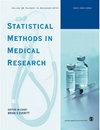Assessing treatment effect heterogeneity in the presence of missing effect modifier data in cluster-randomized trials
IF 1.6
3区 医学
Q3 HEALTH CARE SCIENCES & SERVICES
引用次数: 0
Abstract
Understanding whether and how treatment effects vary across subgroups is crucial to inform clinical practice and recommendations. Accordingly, the assessment of heterogeneous treatment effects based on pre-specified potential effect modifiers has become a common goal in modern randomized trials. However, when one or more potential effect modifiers are missing, complete-case analysis may lead to bias and under-coverage. While statistical methods for handling missing data have been proposed and compared for individually randomized trials with missing effect modifier data, few guidelines exist for the cluster-randomized setting, where intracluster correlations in the effect modifiers, outcomes, or even missingness mechanisms may introduce further threats to accurate assessment of heterogeneous treatment effect. In this article, the performance of several missing data methods are compared through a simulation study of cluster-randomized trials with continuous outcome and missing binary effect modifier data, and further illustrated using real data from the Work, Family, and Health Study. Our results suggest that multilevel multiple imputation and Bayesian multilevel multiple imputation have better performance than other available methods, and that Bayesian multilevel multiple imputation has lower bias and closer to nominal coverage than standard multilevel multiple imputation when there are model specification or compatibility issues.在群组随机试验中评估疗效修饰数据缺失情况下的疗效异质性
了解不同亚组的治疗效果是否存在差异以及如何存在差异,对于指导临床实践和提出建议至关重要。因此,根据预先指定的潜在效应修饰因子评估异质性治疗效果已成为现代随机试验的共同目标。然而,当一个或多个潜在效应修饰因子缺失时,完整病例分析可能会导致偏差和覆盖不足。虽然已经提出了处理缺失数据的统计方法,并对缺失效应修饰因子数据的单独随机试验进行了比较,但很少有指南适用于群组随机设置,因为群组内效应修饰因子、结果甚至缺失机制的相关性可能会进一步威胁异质性治疗效果的准确评估。本文通过对具有连续结果和缺失二元效应修饰因子数据的分组随机试验进行模拟研究,比较了几种缺失数据方法的性能,并使用工作、家庭和健康研究的真实数据进一步说明了这一点。我们的结果表明,多层次多重估算和贝叶斯多层次多重估算比其他现有方法具有更好的性能,当存在模型规范或兼容性问题时,贝叶斯多层次多重估算比标准多层次多重估算具有更低的偏差和更接近名义覆盖率。
本文章由计算机程序翻译,如有差异,请以英文原文为准。
求助全文
约1分钟内获得全文
求助全文
来源期刊

Statistical Methods in Medical Research
医学-数学与计算生物学
CiteScore
4.10
自引率
4.30%
发文量
127
审稿时长
>12 weeks
期刊介绍:
Statistical Methods in Medical Research is a peer reviewed scholarly journal and is the leading vehicle for articles in all the main areas of medical statistics and an essential reference for all medical statisticians. This unique journal is devoted solely to statistics and medicine and aims to keep professionals abreast of the many powerful statistical techniques now available to the medical profession. This journal is a member of the Committee on Publication Ethics (COPE)
 求助内容:
求助内容: 应助结果提醒方式:
应助结果提醒方式:


